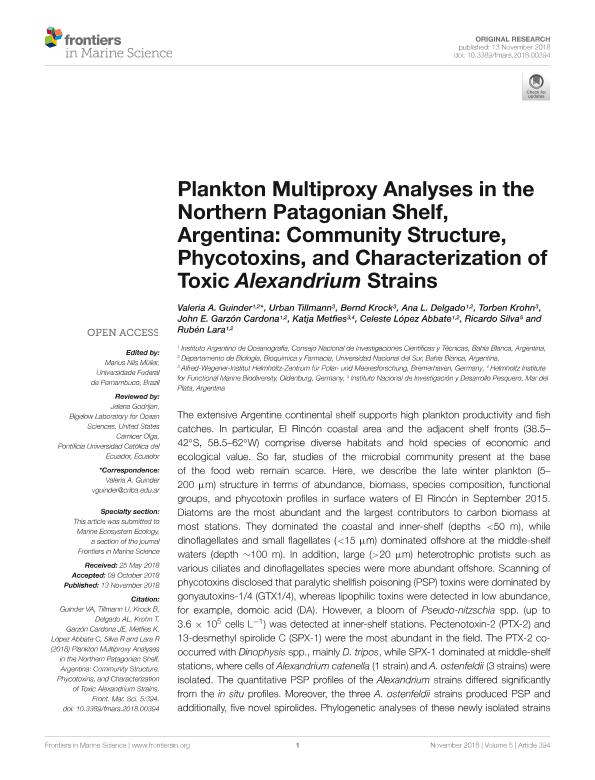Artículo
Plankton Multiproxy Analyses in the Northern Patagonian Shelf, Argentina: Community Structure, Phycotoxins, and Characterization of Toxic Alexandrium Strains
Guinder, Valeria Ana ; Tillmann, Urban; Krock, Bernd; Delgado, Ana Laura
; Tillmann, Urban; Krock, Bernd; Delgado, Ana Laura ; Krohn, Torben; Garzon Cardona, John Edison
; Krohn, Torben; Garzon Cardona, John Edison ; Metfies, Katja; López Abbate, María Celeste
; Metfies, Katja; López Abbate, María Celeste ; Silva, Ricardo; Lara, Ruben Jose
; Silva, Ricardo; Lara, Ruben Jose
 ; Tillmann, Urban; Krock, Bernd; Delgado, Ana Laura
; Tillmann, Urban; Krock, Bernd; Delgado, Ana Laura ; Krohn, Torben; Garzon Cardona, John Edison
; Krohn, Torben; Garzon Cardona, John Edison ; Metfies, Katja; López Abbate, María Celeste
; Metfies, Katja; López Abbate, María Celeste ; Silva, Ricardo; Lara, Ruben Jose
; Silva, Ricardo; Lara, Ruben Jose
Fecha de publicación:
11/2018
Editorial:
Frontiers Media SA
Revista:
Frontiers In Marine Science
ISSN:
2296-7745
Idioma:
Inglés
Tipo de recurso:
Artículo publicado
Clasificación temática:
Resumen
The extensive Argentine continental shelf supports high plankton productivity and fish catches. In particular, El Rincón coastal area and the adjacent shelf fronts (38.5-42°S, 58.5-62°W) comprise diverse habitats and hold species of economic and ecological value. So far, studies of the microbial community present at the base of the food web remain scarce. Here, we describe the late winter plankton (5-200 μm) structure in terms of abundance, biomass, species composition, functional groups, and phycotoxin profiles in surface waters of El Rincón in September 2015. Diatoms are the most abundant and the largest contributors to carbon biomass at most stations. They dominated the coastal and inner-shelf (depths < 50 m), while dinoflagellates and small flagellates ( < 15 μm) dominated offshore at the middle-shelf waters (depth ~100 m). In addition, large ( > 20 μm) heterotrophic protists such as various ciliates and dinoflagellates species were more abundant offshore. Scanning of phycotoxins disclosed that paralytic shellfish poisoning (PSP) toxins were dominated by gonyautoxins-1/4 (GTX1/4), whereas lipophilic toxins were detected in low abundance, for example, domoic acid (DA). However, a bloom of Pseudo-nitzschia spp. (up to 3.6 × 105 cells L-1) was detected at inner-shelf stations. Pectenotoxin-2 (PTX-2) and 13-desmethyl spirolide C (SPX-1) were the most abundant in the field. The PTX-2 co-occurred with Dinophysis spp., mainly D. tripos, while SPX-1 dominated at middle-shelf stations, where cells of Alexandrium catenella (1 strain) and A. ostenfeldii (3 strains) were isolated. The quantitative PSP profiles of the Alexandrium strains differed significantly from the in situ profiles. Moreover, the three A. ostenfeldii strains produced PSP and additionally, five novel spirolides. Phylogenetic analyses of these newly isolated strains from the South Atlantic revealed a new ribotype group, suggesting a biogeographical distinction in the population. The plankton survey presented here contributes baseline knowledge to evaluate potential ecosystem changes and track the global distribution of toxigenic species.
Archivos asociados
Licencia
Identificadores
Colecciones
Articulos(IADO)
Articulos de INST.ARG.DE OCEANOGRAFIA (I)
Articulos de INST.ARG.DE OCEANOGRAFIA (I)
Citación
Guinder, Valeria Ana; Tillmann, Urban; Krock, Bernd; Delgado, Ana Laura; Krohn, Torben; et al.; Plankton Multiproxy Analyses in the Northern Patagonian Shelf, Argentina: Community Structure, Phycotoxins, and Characterization of Toxic Alexandrium Strains; Frontiers Media SA; Frontiers In Marine Science; 5; NOV; 11-2018; 1-21
Compartir
Altmétricas



